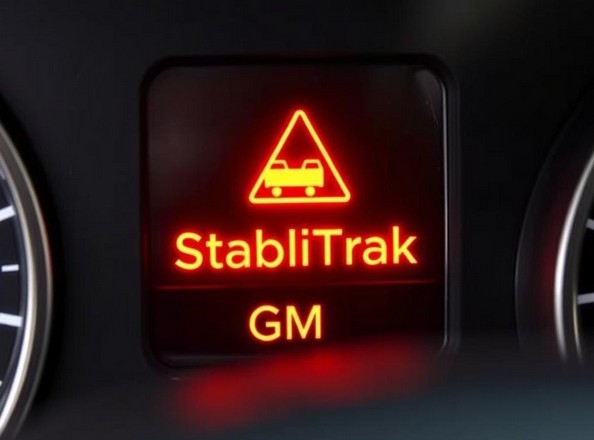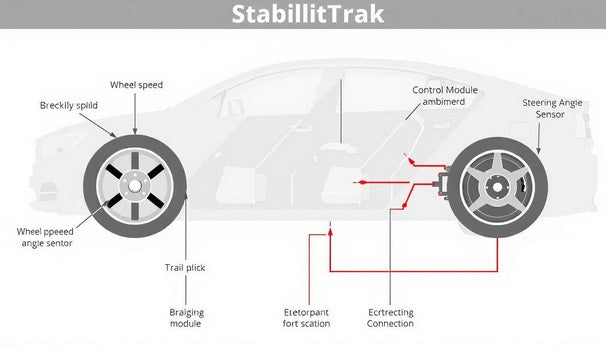You're driving along when suddenly that triangular warning light with "StabiliTrak" appears on your dashboard. Your first thought might be: "Can I keep driving, or do I need to pull over immediately?" This common question affects many GM vehicle owners, and the answer isn't always straightforward. In this comprehensive guide, we'll explore what the StabiliTrak system does, why the warning light might illuminate, and most importantly—whether it's safe to continue driving when it does.
What Is StabiliTrak and How Does It Work?
StabiliTrak is General Motors' proprietary Electronic Stability Control (ESC) system designed to help maintain vehicle control during challenging driving conditions. Unlike standard traction control, which primarily prevents wheel spin during acceleration, StabiliTrak offers comprehensive stability management in various situations.
How StabiliTrak Enhances Vehicle Safety
The system uses a network of sensors to continuously monitor your vehicle's movement and driver inputs. These sensors track:
- Steering wheel position and angle
- Individual wheel speeds
- Vehicle yaw rate (rotation around vertical axis)
- Lateral acceleration (side-to-side movement)
- Throttle position
When StabiliTrak detects a discrepancy between your intended direction (based on steering input) and the vehicle's actual path, it automatically intervenes. The system can selectively apply individual wheel brakes and reduce engine power to help correct the vehicle's course and maintain stability.
Did you know? The National Highway Traffic Safety Administration (NHTSA) found that stability control systems like StabiliTrak reduce single-vehicle crashes by approximately 34% for cars and 59% for SUVs.
Why Is Your StabiliTrak Light On?
The StabiliTrak warning light can illuminate for several reasons, ranging from minor issues to more serious system malfunctions. Understanding these causes helps determine whether it's safe to continue driving.
Common Reasons for StabiliTrak Light Activation
System Temporarily Engaged
Sometimes the light briefly flashes when the system activates during slippery conditions. This normal operation indicates StabiliTrak is working to maintain stability.
Steering Angle Sensor Issues
The steering wheel position sensor is a common failure point that triggers the StabiliTrak light. When this sensor malfunctions, the system cannot accurately determine the driver's intended direction.
Wheel Speed Sensor Problems
Faulty wheel speed sensors send incorrect data about individual wheel rotation rates, confusing the stability control system and triggering the warning light.
Related System Failures
Issues with the Anti-lock Braking System (ABS) often affect StabiliTrak since they share components. When the ABS light illuminates alongside StabiliTrak, it typically indicates a more complex problem.
Electronic Control Module Faults
The electronic brain controlling StabiliTrak can experience communication errors or internal faults that disable the system.
Low Battery Voltage
Insufficient electrical power can cause the StabiliTrak system to shut down as a protective measure, triggering the warning light.
"If only the StabiliTrak light is on, then it is likely the steering wheel position sensor. If you have that light as well as the ABS light on, then it's a fault with the ABS system."
- GM Technical Forum
Safety Risks: Is It Safe to Drive With the Light On?
When the StabiliTrak light illuminates, your vehicle's stability control system is either partially or completely disabled. This raises important safety considerations, especially in challenging driving conditions.
When It May Be OK to Continue Driving
- Dry, clear road conditions with good traction
- Only the StabiliTrak light is on (no other warning lights)
- Vehicle handles normally with no unusual behavior
- Short distance to your destination or service facility
- Light came on after driving through deep water or snow
When You Should Not Continue Driving
- Multiple warning lights are illuminated (ABS, brake, etc.)
- Adverse weather conditions (rain, snow, ice)
- Vehicle handling feels unstable or unpredictable
- Unusual noises from wheels or braking system
- Steering feels loose or unresponsive
Real-World Safety Implications
Without StabiliTrak, your vehicle loses a significant safety feature designed to prevent accidents. The system is particularly valuable in emergency maneuvers and slippery conditions where stability control makes the difference between maintaining control and losing it.
Important Safety Note: According to GM's official stance in owner manuals, driving with the StabiliTrak system disabled reduces vehicle control during difficult driving conditions and increases the risk of accidents. While not always an emergency, it should be addressed promptly.
Don't Take Chances With Your Safety
If you're concerned about driving with your StabiliTrak light on, professional mechanics can quickly diagnose the issue and recommend the safest course of action.
Immediate Actions When the StabiliTrak Light Comes On
When the StabiliTrak light illuminates, there are several immediate steps you can take to potentially resolve the issue or determine its severity before deciding whether to continue driving.
1. Pull Over Safely
Find a safe location to stop your vehicle, especially if you notice any handling issues or multiple warning lights.
2. Restart Your Vehicle
Turn off the engine completely, wait 20-30 seconds, and restart. This simple reset often clears temporary electronic glitches.
3. Check Other Warning Lights
Note if other dashboard lights are illuminated alongside StabiliTrak, particularly the ABS or Check Engine lights.
Simple Reset Methods
For many drivers, these basic reset procedures can temporarily resolve StabiliTrak warnings:
- Key Cycle Reset: While driving, turn the key to the START position momentarily (without shutting off the engine). This can reset the system in some GM vehicles.
- Battery Terminal Reset: If safe to do so, disconnect the negative battery terminal for 10-15 minutes, then reconnect. This forces a complete system reset.
- StabiliTrak Button: Some vehicles have a StabiliTrak button. If it was accidentally turned off, press and hold to reactivate the system.
Quick Tip: If the StabiliTrak light returns immediately after a reset attempt, particularly during turning or braking, this indicates a persistent issue requiring professional diagnosis.
Long-Term Solutions and Repair Options
While temporary resets might clear the StabiliTrak light momentarily, addressing the underlying issue is essential for permanent resolution and restored safety features.
Common Repairs and Cost Estimates
|
Component |
Common Issues |
Repair/Replacement Cost |
DIY Difficulty |
|
Steering Angle Sensor |
Calibration errors, internal failure |
$150-$400 |
Moderate |
|
Wheel Speed Sensors |
Dirt accumulation, wiring damage |
$120-$300 per sensor |
Moderate |
|
ABS Module |
Electronic failure, water damage |
$600-$1,200 |
Advanced |
|
Wiring Harness |
Shorts, breaks, corrosion |
$200-$600 |
Advanced |
|
Electronic Brake Control Module |
Internal failure, programming errors |
$700-$1,200 |
Professional only |
Professional Diagnostic Process
Professional mechanics follow a systematic approach to diagnose StabiliTrak issues:
- Code Retrieval: Using an OBD-II scanner to identify specific fault codes
- Component Testing: Checking individual sensors and modules for proper function
- Wiring Inspection: Examining connections and harnesses for damage
- System Calibration: Recalibrating sensors after repairs when necessary
- Road Testing: Verifying the fix under actual driving conditions
StabiliTrak Light vs. Other Dashboard Warnings
Understanding how the StabiliTrak warning compares to other dashboard indicators helps prioritize your response appropriately.
|
Warning Light |
Severity Level |
Safe to Drive? |
Recommended Action |
|
StabiliTrak Light Only |
Moderate |
Usually, with caution |
Schedule service soon |
|
StabiliTrak + ABS Light |
Moderate-High |
Limited distance only |
Service within 1-2 days |
|
StabiliTrak + Brake Warning |
High |
Not recommended |
Immediate service |
|
StabiliTrak + Check Engine |
Moderate-High |
Limited distance only |
Service within 1-2 days |
|
Red Brake Warning Light |
Very High |
No |
Stop immediately |
The StabiliTrak light alone generally indicates a moderate concern that doesn't require immediate action in safe driving conditions. However, when combined with other warning lights, the severity increases significantly and may indicate a comprehensive braking or stability system failure.
Real-World Scenarios: When You Can Continue Driving
While it's generally best to address StabiliTrak warnings promptly, certain situations may allow for continued driving with appropriate caution. Here are real-world scenarios where driving with the StabiliTrak light on might be acceptable:
Scenario 1: Temporary Activation in Poor Conditions
If you're driving through heavy rain, snow, or on gravel roads, the StabiliTrak light might flash or illuminate temporarily as the system works to maintain stability. Once conditions improve, the light often turns off automatically. In this case, the system is functioning as designed, and you can continue driving normally.
Scenario 2: Light Appears After Battery Service
After a battery replacement or disconnect, various vehicle systems may need recalibration. The StabiliTrak light might appear until the system relearns certain parameters. In this situation, driving for 10-15 minutes on a straight, level road often allows the system to recalibrate itself.
Scenario 3: Remote Location with Limited Service Options
If the StabiliTrak light appears when you're in a remote area far from service facilities, and the vehicle otherwise handles normally, you can typically continue to your destination or the nearest service center. Drive cautiously, avoid aggressive maneuvers, and be especially careful in turns or on slippery surfaces.
Scenario 4: Known Sensor Issue with Scheduled Repair
If you've already diagnosed a minor issue like a steering angle sensor problem and have a repair scheduled, continuing to drive carefully until your appointment is generally acceptable. Avoid challenging driving conditions and be aware that your vehicle's stability assistance is compromised.
Remember: Even in these scenarios, exercise extra caution, especially in adverse weather or road conditions. Your vehicle's ability to maintain stability in emergency situations is compromised when the StabiliTrak system is disabled.
Preventive Maintenance to Avoid StabiliTrak Issues
Proactive maintenance can significantly reduce the likelihood of experiencing StabiliTrak warnings and ensure your vehicle's stability control system functions properly when you need it most.
Regular Inspection Practices
- Check wheel speed sensors for debris accumulation or damage during tire rotations
- Inspect brake system components regularly, as they share functionality with StabiliTrak
- Maintain proper tire pressure and condition to ensure accurate sensor readings
- Keep battery connections clean and secure to prevent electrical issues
- Follow manufacturer-recommended service intervals for brake fluid replacement
Driving Habits That Protect Your System
- Avoid deep water crossings that can damage electrical components
- Drive cautiously on extremely rough terrain to prevent sensor damage
- Allow systems to warm up before aggressive driving in cold weather
- Address check engine lights promptly, as they can affect StabiliTrak
- Use appropriate driving modes for conditions (if equipped)
Pro Tip: Consider having your vehicle's computer systems checked during regular service intervals. Many dealers and service centers can update electronic control modules with the latest manufacturer software, which often resolves known issues before they trigger warning lights.
DIY Troubleshooting Before Seeking Professional Help
Before scheduling a potentially expensive service appointment, several DIY troubleshooting steps might help identify or even resolve the StabiliTrak warning.
Basic Inspection and Testing
- Check for loose connections: Inspect visible sensors around wheel hubs and steering column for loose wiring
- Examine fuses: Locate the fuse box and check fuses related to the ABS and StabiliTrak systems
- Clean wheel sensors: If accessible, carefully clean wheel speed sensors using electrical contact cleaner
- Verify tire condition: Ensure all tires are properly inflated and show even wear patterns
- Test battery voltage: Low voltage can trigger system warnings; confirm battery is charging properly
Using an OBD-II Scanner
For more advanced troubleshooting, an OBD-II scanner can retrieve specific error codes that pinpoint the exact issue:
Common StabiliTrak Error Codes
- C0561: Steering angle sensor circuit malfunction
- C0035-C0048: Wheel speed sensor circuit issues
- U0121: Lost communication with ABS module
- C0186: Yaw rate sensor circuit malfunction
- C0196: Lateral accelerometer circuit issue
Scanner Procedure
- Connect scanner to the OBD-II port (usually under dashboard)
- Power on and select "Read Codes" function
- Navigate to "ABS/StabiliTrak" system (not just engine codes)
- Record all codes for reference
- Research codes online for specific troubleshooting steps
Need Professional Diagnosis?
If your troubleshooting efforts haven't resolved the StabiliTrak warning, professional diagnostic services can quickly identify the exact issue and provide repair options.
Conclusion: Balancing Safety and Convenience
The StabiliTrak light on your dashboard represents an important safety notification that deserves attention, but it doesn't always indicate an emergency situation. Understanding the system's purpose and the warning light's significance helps you make informed decisions about when it's safe to continue driving and when immediate service is necessary.
While driving with the StabiliTrak light on is possible in many circumstances, especially on dry, clear roads with good traction, remember that your vehicle's stability control capabilities are compromised. This increases risk during emergency maneuvers or adverse conditions. The safest approach is to have the system diagnosed and repaired promptly to restore this important safety feature.
By following the troubleshooting steps outlined in this guide, you can potentially resolve minor issues yourself or at least gather valuable information before seeking professional assistance. Whether you're dealing with a simple sensor calibration or a more complex electronic issue, addressing StabiliTrak warnings ensures your vehicle maintains optimal handling and safety characteristics in all driving conditions.




Leave a comment
This site is protected by hCaptcha and the hCaptcha Privacy Policy and Terms of Service apply.